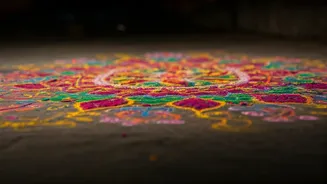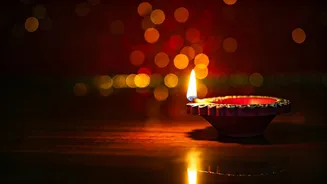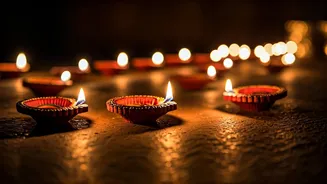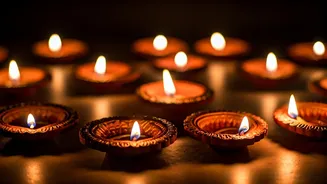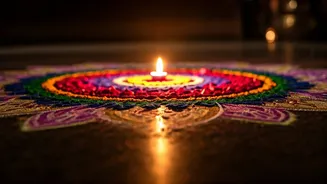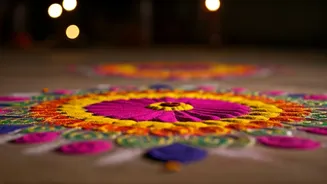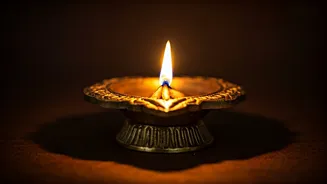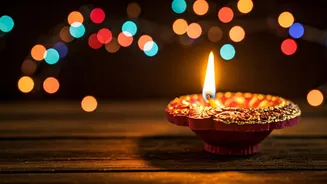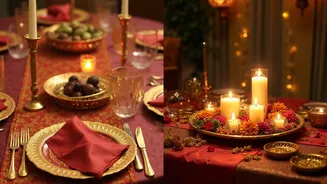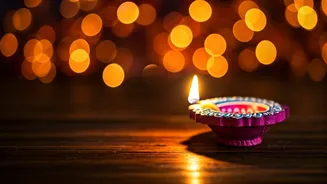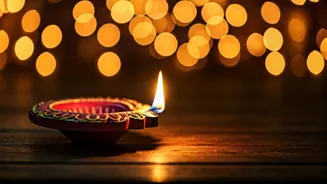Tradition and Significance
Rangoli holds deep cultural significance, particularly during Diwali. It's not merely decoration but a symbol of welcome, prosperity, and good fortune.
Creating Rangoli is a way to invite the Goddess Lakshmi into homes, believed to bring wealth and happiness. The art form has evolved over centuries, passed down through generations. Traditionally, Rangoli patterns were drawn using rice flour, colored sand, or flower petals. These materials were chosen not only for their beauty but also for their symbolic meanings, such as purity, abundance, and the connection to nature. The act of creating Rangoli is also considered a collective activity. Families and communities often come together to design and complete these elaborate patterns, fostering a sense of unity and shared celebration. The vibrant colors and intricate designs used during Diwali represent joy, celebration, and the triumph of good over evil. Rangoli is more than just an aesthetic addition; it is an expression of cultural heritage and the joyous spirit of Diwali.
Essential Rangoli Materials
To create beautiful Rangoli designs, you'll need the right materials. The most common and essential materials include Rangoli colors, which are available in vibrant shades. These colors can be in powder or liquid form, offering flexibility in design. Fine-tip bottles or squeeze bottles are helpful for precise application of colors, especially for intricate patterns. Rice flour, typically used as a base, provides a natural and traditional touch, creating a smooth surface. For added textures and effects, you can use colored sand, flower petals, and even colored pulses or grains. Stencils are incredibly useful, especially for beginners or those aiming for symmetry and complex patterns. Additionally, tools like small brushes or cotton swabs can help refine details and blend colors seamlessly. A clean, flat surface is crucial, often the floor or a clean area outside the home. Remember to have a damp cloth or a sponge available to clean up any spills or errors as you work. Finally, consider using a border or outline to define the Rangoli design, making it stand out more effectively.
Simple Rangoli Designs
If you're new to Rangoli or prefer something easy, several simple designs can still make a striking impact. Geometric patterns, such as circles, squares, and triangles, are a great starting point, allowing for easy symmetry and quick creation. You can create a central flower pattern using simple floral shapes or even a lotus design, often associated with prosperity. Dot Rangoli involves creating a grid of dots and connecting them with lines and curves, resulting in a variety of patterns. Freehand designs, where you draw the pattern directly without stencils or guides, are also an option. Using a limited color palette—such as two or three colors—can simplify the process and still deliver a vibrant look. Another easy approach is to use stencils, which are available in various shapes and sizes. Stencils offer precision, allowing you to fill in the design with colors quickly. Choose a spot near the entrance of your home, drawing a design that welcomes guests with festive cheer. Remember that simple does not mean less beautiful; well-executed, straightforward designs can be just as impressive as more intricate ones.
Intricate Rangoli Patterns
For those seeking to explore more detailed Rangoli, there are numerous intricate patterns to choose from. Peacock designs, with their elaborate feathers and vibrant colors, are popular and add a touch of elegance. Mandala designs, known for their circular and symmetrical patterns, offer a sense of balance and harmony. Floral motifs, ranging from detailed lotuses to stylized flowers, can add grace and beauty to your designs. Themes inspired by traditional Indian art forms, like Madhubani or Warli art, can be incorporated for a unique touch. Using multiple colors and blending them to create gradients can increase visual interest and depth. Incorporating elements like diyas (oil lamps), or other traditional symbols adds cultural richness to your Rangoli. Achieving intricate patterns requires patience and a steady hand. Start with a rough sketch or outline before filling in the colors. Use fine-tipped bottles or brushes for precise color application and layer the colors gradually to create depth and detail. Remember to take your time, and enjoy the process of bringing your creative vision to life.
Color Palette Choices
Selecting the right colors is vital to enhancing the visual appeal of your Rangoli. Traditional Diwali colors include vibrant reds, oranges, yellows, greens, and blues, which symbolize energy, joy, and prosperity. You can explore a monochromatic theme, using different shades of the same color, to create a sophisticated and modern look. Complementary color schemes, like red and green, or blue and orange, can generate a striking contrast, making the design stand out. Analogous color schemes, where you use colors next to each other on the color wheel, can establish a harmonious and visually pleasing composition. When selecting your colors, consider the surroundings where the Rangoli will be placed and the overall ambiance you wish to create. For a traditional feel, you might choose bright, bold colors; for a more contemporary look, use muted or pastel shades. Ensure the colors are of good quality, and don't bleed or fade, especially if the Rangoli will be exposed to sunlight or moisture. Experiment with different combinations to find the color palette that best reflects your style and festive mood.
Placement and Setting
The placement of your Rangoli can significantly impact its overall effect. The entrance of your home is a traditional spot, welcoming guests and setting a festive tone. Create a design on the doorstep, the hallway, or in the pooja room. The center of the living room or dining area offers a focal point, drawing attention and adding a celebratory feel. Consider creating multiple smaller Rangoli designs in different areas of your home to spread the festive atmosphere. Ensure the surface is clean and dry before starting and that the area is well-lit to aid in design. If your Rangoli is outdoors, protect it from wind and rain. You might place a temporary covering over it or use materials that are less susceptible to weather damage. Adding lighting around the Rangoli, such as diyas or fairy lights, will enhance its beauty and make it more visible, especially during evening celebrations. Think about the scale and size of the Rangoli relative to its surroundings. A large design in a spacious area or a smaller, more intricate design in a compact space can achieve different aesthetic effects.
Maintenance and Preservation
Once you've created a beautiful Rangoli, protecting it is important. If indoors, avoid areas with heavy foot traffic to prevent the design from being disturbed or smudged. If the Rangoli is outdoors, take measures to protect it from the elements. Lightly spray the Rangoli with a clear sealant to prevent colors from fading or running if rain is a concern. Avoid sweeping the area around the Rangoli. Instead, use a soft brush or a vacuum cleaner with a brush attachment to remove dust and debris. If any part of the Rangoli gets damaged, have the necessary colors on hand to make quick touch-ups. When the festival ends, dispose of the Rangoli materials responsibly, especially if they are made of natural ingredients like flower petals or rice flour. In case you wish to preserve the design for a longer duration, consider taking a photograph of your finished Rangoli so you can refer to it later. By following these maintenance tips, you can ensure your Rangoli remains a beautiful and vibrant centerpiece throughout the Diwali festivities.
